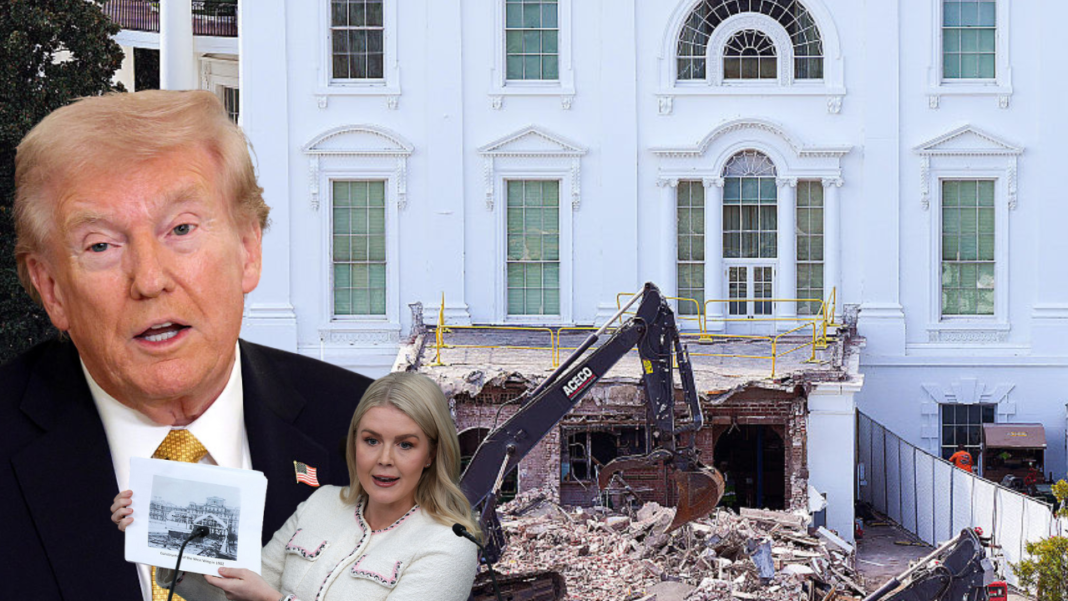White House Demolition of the East Wing: A Bold Move Under Trump
The recent demolition of the East Wing of the White House has stirred considerable debate and controversy. Initially, the Trump administration had assured the public that the structure would remain intact while building a proposed ballroom. However, the reality turned out to be quite different, sparking questions about transparency and the motivations behind this significant renovation.
A Transformational Vision
White House Press Secretary Karoline Leavitt defended the decision to demolish the East Wing, emphasizing that this bold move will add a “magnificent” element to the White House for years to come. “It’s not costing the taxpayers anything,” she reiterated during a press briefing, presenting the administration’s rationale for the project. The ballroom, originally budgeted at $200 million, is now estimated to cost $300 million—a figure that has drawn scrutiny amid widespread economic challenges faced by many Americans.
Transparency in Funding
Leavitt assured reporters that the entire ballroom project would be privately funded, with contributions from donors, including President Trump himself. This commitment to transparency includes an intention to release a comprehensive list of donors and their contributions, indicating a shift towards accountability in a project of such magnitude. “The president has been incredibly transparent,” Leavitt asserted, aiming to quell any doubts about the funding sources.
Change of Plans
The decision to demolish the East Wing did not come lightly. According to Leavitt, President Trump shifted his stance after receiving advice from architects and construction companies. They suggested that taking this step was essential for creating a modern and stable structure that would stand the test of time. “This phase one that we’re now in was necessary,” she explained, positioning the demolition as a necessary evolution rather than an impulsive choice.
Legal Considerations and Oversight
One of the pressing questions raised during the briefing involved the legal implications of tearing down such a historic structure. CBS News White House Correspondent Weijia Jiang challenged Leavitt, asking if the president believes he can undertake major demolitions without oversight. Leavitt responded by clarifying that the National Capital Planning Commission (NCPC), which oversees planning guidance for Washington, D.C., does not require submissions for demolitions—only for new vertical constructions. This highlights a nuanced legal framework that allows for significant changes without extensive oversight.
Historical Context of Renovations
The current situation has not escaped comparison to past renovations at the White House. Leavitt pointed out that numerous presidents have undertaken demolitions and renovations to modernize the historic residence, including Richard Nixon, who transformed a basement pool into the James Brady Press Briefing Room. Images showcasing previous renovations were presented, underscoring a legacy of change that spans decades.
Public Sentiment and Critique
Despite the administration’s defense, the demolition has faced heavy criticism. Former White House aides have labeled the undertaking as a costly “vanity project,” especially in light of pressing economic issues affecting millions of Americans. Jeremy Edwards, a former White House spokesperson, remarked that the destruction of the East Wing serves as a “perfect metaphor” for what Trump has done to the country and the economy.
Impact on White House Operations
With the demolition raising eyebrows, questions have also emerged regarding the future of the White House. When asked if any further renovations were planned, Leavitt indicated that, to her knowledge, no additional projects were on the horizon. Nonetheless, she acknowledged Trump’s nature as a builder, hinting at potential future interests in improving the White House grounds.
The Quest for a Name
As plans for the ballroom continue to take shape, anticipation grows about what it will ultimately be named. Leavitt mentioned that the president would announce the name once it has been firmly decided, keeping an air of mystery around this ambitious addition to the historic residence.
The unfolding narrative of the East Wing demolition showcases a complex interplay of ambition, legal considerations, and public opinion, making it one of the more controversial aspects of the Trump presidency.



